Menus
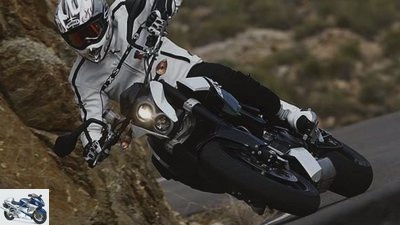
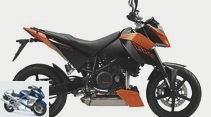
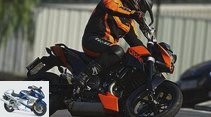
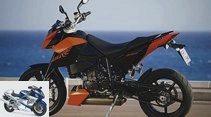
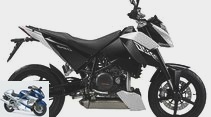
8th photos
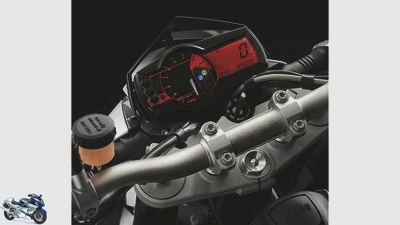
KTM
1/8
KTM 690 Duke
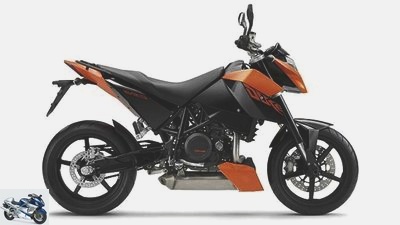
KTM
2/8
KTM 690 Duke
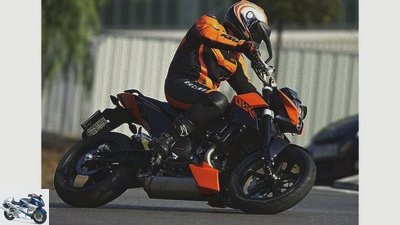
KTM
3/8
KTM 690 Duke
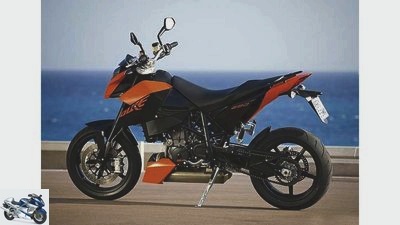
KTM
4/8
KTM 690 Duke
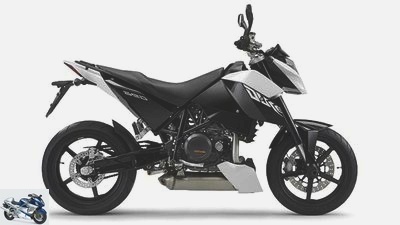
KTM
5/8
KTM 690 Duke
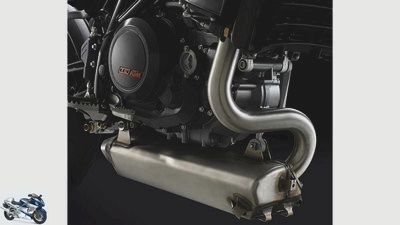
KTM
6/8
KTM 690 Duke
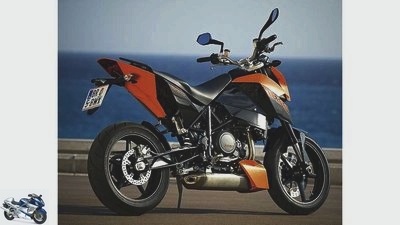
KTM
7/8
KTM 690 Duke

KTM
8/8
KTM 690 Duke
Driving report KTM 690 Duke
Black on white
New engine, new chassis, new paintwork ?? after 15 years, the Duke’s model development is continued. And for the followers of the pure KTM teaching, the all-clear can be given: They are also available in orange.
It had cult status from the start, the KTM Duke. The Austrians presented the speedster at the end of 1992. A real sensation back then, a mixture of enduro, supermoto and streetfighter that is still unique today. Certainly not a motorcycle for the masses, but a dream for curvy single freaks. Recently, however, the iconic single-cylinder was getting a little old. The jarring drive no longer met modern requirements, and the torsion-free chassis was also no longer entirely up to date.
Time for a generation change. Visually, the new 690 Duke ties in with the oldie, but technically it has nothing to do with it. Of course, the new edition of the Duke did not come as a complete surprise. Because already last year KTM put the concept of the large-volume single cylinder on a fresh basis with the 690 Supermoto. A completely redesigned LC4 single with gasoline injection and a tubular space frame replaced the legendary original version. With an impressive result: The 690 SM literally outclassed the assembled competition of single-cylinder funbikes in a comparative test by MOTORRAD (issue 13/2007). The almost ingenious, nimble and excellently sprung chassis impressed, the engine with measured 66 HP defined a new dimension in terms of performance of single cylinders. Even if its easy-turning character reflects the traditional values of stews ?? the rumbling-full start from the speed cellar? simply ignored.
The Duke is also committed to this credo. She can’t help it. Because despite the outwardly clearly different alignment compared to the 690 Supermoto, the technical differences (see box) remain manageable. The suspension travel, which was cut to 140 millimeters at the front and rear, only enabled the most obvious visual revision: the so-called underfloor exhaust, which, with its position hidden under the engine housing, moves as far as possible from the stylistically controversial sidepipes of the Supermoto version. The moderate seat height of 860 millimeters associated with the lowering gives the Duke immediate approval at first contact. As you are used to from the 690 SM, the seating position is relatively far forward, and the knees are narrow thanks to the offset tank flanks. Press the button: Even the sound hardly differs from the well-muffled bollern of the Supermoto edition.
Good vibrations
Jahn
Good workmanship and top equipment are a matter of honor at Duke.
And already in the first few meters, the single confirms its character anew. The short-stroke engine doesn’t like it below 3000 rpm, then it jerks and chops, warns of higher speeds in order to say thank you for turning the throttle just a few revolutions above. Because not only does a bearable level of vibrations set itself in a flash, it also progresses rapidly until the rev limiter intervenes at 8600 rpm. The four-valve engine greedily climbs the speed ladder, literally screaming for sporting challenges.
It cannot be determined with certainty whether the camshaft, which has been modified compared to the Supermoto, with sharper control times also pushes the forward thrust. Actually also secondary. Nominally three HP more than with the Supermoto, i.e. 65 HP, is enough for a full adrenaline rush in the curves with a weight of almost 160 kilograms. The rotary switch on the right above the motor housing, which can be used to select two other mappings of the motor management in addition to the standard setting, can be used with confidence. Level one transforms the Sprinter into a toothless Volkswanderer with 30 percent less power with significantly less power over the entire speed range.
In stage two, the throttle response should be more direct and aggressive compared to the standard setup, in that the servomotor of the throttle valve is virtually linearly connected to the throttle position. Which is hardly noticeable in practice. With the Enduro (driving report in MOTORRAD 5/2008) different mappings may make sense, but the standard setting is sufficient for the Duke driver. After all: the critical idling behavior of the single-cylinder, known from the 690 SM, which occasionally resulted in sudden death in city traffic, is no longer an issue thanks to the new mapping in the Duke. Back on the country road. The ultra-lively engine continues to impress with its light-as-a-feather anti-hopping clutch and precisely locking gear. The brakes can be dosed well enough, but despite four individual pads per brake caliper, they require force on the hand lever and do not work as a one-finger brake.
The actually playful handling also requires driving know-how. Still neutral at a moderate pace, the Duke tends to lurch slightly in turns when the pace is forced. Whether it’s because of the otherwise very neutral Dunlop tires (Sportmax GPR a-10) or the not quite homogeneous, relatively soft at the front, but taut rear suspension design ?? the phenomenon disappears as soon as the Duke is held under tension. In this respect, she remains true to herself even in a revamped outfit and with new technology: as the freaky sister of the Supermoto.
Data KTM 690 Duke
Jahn
All-clear for the followers of pure KTM teaching: the KTM 690 Duke is also available in orange.
Engine:
water-cooled single-cylinder engine, a balance shaft, an overhead, chain-driven camshaft, four valves, injection, regulated catalytic converter, oil bath clutch, six-speed gearbox, O-ring chain.
Bore x stroke: 102.0 x 80.0 mm
Displacement: 654 cm³
Compression ratio: 11.8: 1
Rated output: 48.0 kW (65 hp) at 7500 rpm
Max. Torque: 67 Nm at 5500 rpm
Landing gear:
Steel tubular frame, upside-down fork, ø 48 mm, adjustable spring base, rebound and compression damping, aluminum swing arm, central spring strut with lever system, adjustable spring base, rebound and compression damping, front disc brake, ø 320 mm, rear, ø 220 mm.
Cast aluminum wheels: 3.50 x 17; 5.00 x 17
Tires: 120/70 ZR 17; 160/60 ZR 17
Mass and weight:
Wheelbase 1472 mm, steering head angle 63.5 degrees, caster 115 mm, spring travel f / r 140/140 mm, seat height 865 mm, tank capacity / reserve 13.5 / 2.5 liters.
Guarantee: two years
Colours: Silver, orange
Price: (including additional costs) 9195 euros
Related articles
-
Jahn driving report KTM Creme 21: 690 Enduro It’s the year 1987. With the LC4, the Austrians provide an uncompromising …
-
Driving report KTM 990 Super Duke
Jahn Fahrbericht KTM 990 Super Duke Facelift With its head held high, the Super Duke is slipping into its second term of office. A newly contoured nose that …
-
Driving report KTM 950 Supermoto R
Peuker driving report KTM 950 Supermoto R R-lebnis Smooth running engine, first-class chassis, casual seating position ?? the 950 KTM proves that …
-
Kunstle driving report MZ 1000 S (2003) Upswing East Former Federal Chancellor Helmut Kohl conjured him up after the fall of the Wall, MZ boss Petr Karel Korousebenso …
-
KTM 1090 Adventure in the driving report
KTM 18 pictures KTM 1/18 KTM 1090 Adventure KTM 2/18 KTM 1090 Adventure. KTM 3/18 Simple LCD dashboard with riding modes, ABS and traction control …
-
Driving report: Ducati Hypermotard 1100 Evo-Evo SP
Photo: Ducati 22 pictures Ducati 1/22 Ducati Hypermotard 1100 Evo SP Ducati 2/22 Ducati Hypermotard 1100 Evo SP Cockpit Ducati 3/22 Ducati Hypermotard 1100 …
-
Innovations 2004: Driving report Kawasaki KX 250 F
fact novelties 2004: Driving report Kawasaki KX 250 F late bloomer With a significant delay, Kawasaki is now jumping on the four-stroke train, the Yamaha …
-
Archive pictures Aprilia RSV mille SP and the driving report from MOTORRAD 17-1999
markus-jahn.com 15 pictures markus-jahn.com 1/15 In fact, the engine of the Aprilia RSV mille SP has been thoroughly modified. All around were found …
-
Driving report KTM 1290 Super Duke R
Photo: KTM 23 photos KTM 1/23 There is no competition! Pithy words, but you have to agree with KTM press man Thomas Kuttruf. KTM 2/23 seat and rear …
-
Photo: manufacturer 7th photos Manufacturer 1/7 The new KTM 390 Duke at Eicma. Manufacturer 2/7 The new KTM 390 Duke at Eicma. Manufacturer 3/7 The new…